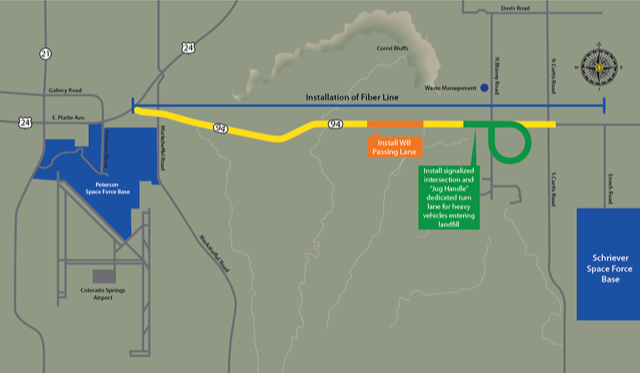Construction Begins on Phase 2 of Colorado 94 Safety Improvements
Travel Advisory
Colorado Springs — Colorado Department of Transportation and contractor, SEMA Construction, Inc. begins construction in mid-April on Phase 2 of the CO 94 Safety Improvement component of the Military Access, Mobility & Safety Improvement Program (MAMSIP) funded through a federal BUILD Grant.
Construction consists of an addition of an eastbound turn lane between North Franceville Coal Mine Road and Blaney Road, and installing a signalized “jug handle” intersection at Blaney Road, thereby removing slowing traffic from the passing lane, and greatly improving efficiency of eastbound traffic. This phase of the project is expected to be complete in December 2022 (weather dependent).
“We are excited to get started on this phase of the Colorado 94 project. It will ensure greater efficiency and safety of military personnel, their families, the overall community and with transport of equipment to and from Peterson Air Force Base, Schriever Air Force Base and Fort Carson,” said CDOT Regional Transportation Director Richard Zamora.
CO 94 Project Overview
The CO 94 project comprises of three elements, each aimed at improving safety and efficiency along the corridor:
- Addition of a westbound passing lane, increasing efficiency and safety conditions between North Franceville Coal Mine Road and US 24 - COMPLETE
- Instead of a standard left turn, from the left lane to northbound Blaney Road, left-turning traffic will use a ramp on the right side of the road; thereby, removing slow moving traffic from the passing lane, and greatly improving efficiency of eastbound traffic
- Installation of fiber optic cables from US 24 to Enoch Road, enabling future installation of ‘Intelligent Transportation System’ elements along the corridor and also enabling high speed communications for future planned development - COMPLETE
CO 94 Safety Benefits
- The safety enhancements relate to the potential to reduce crashes, improve infrastructure, and address physical deficiencies that contribute to crashes in the corridor. CDOT conducted a safety assessment for the corridor to evaluate the magnitude and nature of safety problems and analyze the causes of crashes.\
- The proposed transportation improvements are mitigation measures to reduce crashes and improve safety in the corridor. These improvements include a westbound passing lane, intersection signalization, and turn lanes to address and significantly reduce the number and severity of traffic accidents.
Background Information
The two military installations connected by CO 94, Peterson and Schriever, are the global headquarters of NORAD and the Department of Defense’s (DOD) operational center for the Global Positioning Systems (GPS), respectively. Together, they employ approximately 15,000 military and civilian personnel.
Eastbound daytime traffic along CO 94 is characterized by recurrent congestion caused by steep grades, limited opportunities for passing, and a high volume of slow-moving heavy vehicles traveling to the Waste Management Landfill – Colorado Springs. The heavy vehicles tend to queue up in the (left) passing lane of eastbound CO 94 beginning more than a mile before the turn off to the landfill on N. Blaney Road. This limits sight lines due to queuing of heavy vehicles, coupled with steep grades which leads to the regular occurrence of significant accidents.

Project Information
For additional information about this project:
- Register for Alerts: Text MAMSIP to 888-970-9665
- Call the project information line at 719-800-2162
- Email the project team at: [email protected]
- Visit the project website at: https://www.codot.gov/projects/militaryaccesssafetyimprovements
Remember: Slow For The Cone Zone
The following tips are to help you stay safe while traveling through maintenance and construction work zones.
- Do not speed in work zones. Obey the posted speed limits.
- Stay Alert! Expect the unexpected.
- Watch for workers. Drive with caution.
- Don't change lanes unnecessarily.
- Avoid using mobile devices such as phones while driving in work zones.
- Turn on headlights so that workers and other drivers can see you.
- Be especially alert at night while driving in work zones.
- Expect delays, especially during peak travel times.
- Allow ample space between you and the car in front of you.
- Anticipate lane shifts and merge when directed to do so.
- Be patient!
